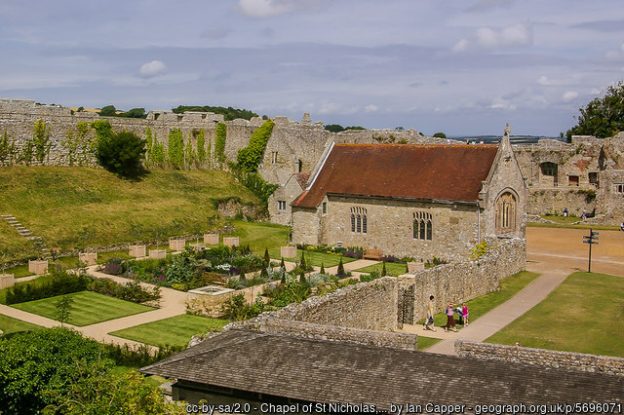[Warning: This post concerns an instance of sexual violence]
Documents in the King’s Bench indictment file for Hilary term 1448, and an entry on the King’s Bench plea roll, deal with the death of a woman, Joan wife of John Couke, and with accusations against a vicar on the Isle of Wight, with regard to Joan’s last few hours.[i]
Joan’s death had been the subject of a coroner’s inquest at Newport on the Isle of Wight, on Tuesday 12th September, 1447. At this inquest, the twelve jurors said on oath that John Hunter, vicar of the chapel of St Nicholas within the castle of Carisbrooke,[ii] came to Newport with force and arms (sample arms specified), against the peace of the lord king, and broke into and entered the close of a certain Edward Brutte, wrongfully, between the hours of nine and ten at night on Monday 11th Sept, 1447. There and then, he raped[iii] Joan, feloniously, and lay with her carnally. On encountering the pair in the act of intercourse,[iv] John Couke raised the hue and cry. At this, Joan fled, for shame and fear,[v] through the street called Holyrodstret, to the stream called Douks Brouke. She was found dead, with her throat cut, in this stream at around 7 a.m. on 12th September, by one John Mabyll of Newport, glover. The jurors did not know who had killed her. ‘Therefore they said that John Hunter had caused her death.’[vi]
The matter was brought before the King’s Bench fairly swiftly – in late January, 1448, for once, an accused person who did not attempt to delay things. John Hunter said that he did not need to answer this accusation, because the indictment was not sufficient in law: the coroner did not have the power to inquire into such a matter. The court agreed that it was insufficient, and John Hunter was acquitted.
So what?
Following the usual monotonous pattern, we see yet another man (and yet another churchman) accused of sexual misconduct going free. It is important to register that. There are, however, some quite unusual aspects, hints of thinking by those involved in medieval ‘criminal justice’ which seem worth pointing out.
First, there is the narrative around the sexual offence. It features that lack of conformity with modern, consent-based, definitions of rape, and that disturbing tendency towards assigning culpability to the penetrated woman, through linguistic implication of willed action on her part. Joan is portrayed – presumably with some plausibility – as having been shamed as well as afraid, and running from the hue and cry, as if to suggest that she would be held to have been at fault.
Then there is the causation point, and it could be argued that this goes against the ideas of ‘victim-blaming’, or adoption of the rape myth that all or most women actually are complicit in their own violation. Although their attempt to form a workable indictment was, in the end, rejected by the court, the inquest jurors did choose to tell the story of the rape of Joan, in a forum which was, strictly, supposed to be confined to ‘how the deceased came by her death’ – i.e. the immediate context of that throat-slitting which occurred some hours after the rape, and which was perpetrated by person or persons unknown, and they did attempt to place blame for the death on the rapist, John Hunter, not in the sense of saying that he slit Joan’s throat, but in the broader sense that he had been culpable in creating the situation which led to her death. Ideas about causation are often rather hard to discern in the brief records of the medieval common law, so it is very interesting to see them emerging above the surface here. Causation is far from a straightforward issue, and continues to be debated in criminal law, and in tort. In truth, there is a large degree of moral choice as opposed to clear, logical, inevitability, about decisions that A caused B. This does seem to be something of an outlier, in arguing that a person should be held culpable in relation to a death perpetrated by another, on a person he harmed in a terrible but non-fatal way, at some distance in space and time from the scene of his crime. Wouldn’t it be good to be able to see how they arrived at this interpretation?
Of course, it is possible to reconcile these two apparently inconsistent aspects of the case, by imagining that, although the jurors would often in fact have been unsympathetic to a woman who was raped, their allegation that Hunter had caused Joan’s death was caused by the fact that they were really, really hostile to this particular vicar, and wished to do him a bad turn.
GS
2/7/2022
[i] Completists may also want to see this.
[ii] As pictured – sort of – the medieval chapel was demolished and rebuilt, as can be seen from this,.
[iii] It’s a rapuit, with all of the potential uncertainty of that word. It seems appropriate to me to translate it as ‘raped’ here.
[iv] carnaliter communicantibus, I think.
[v] pro pudore et timore
[vi] fuit causa mortis prefate Johanne
